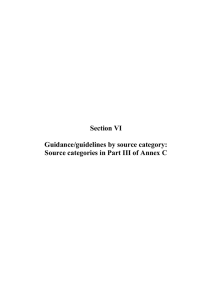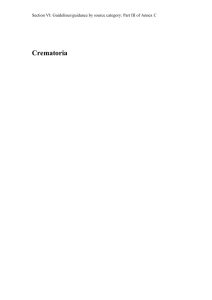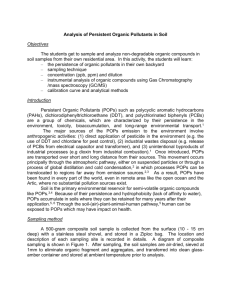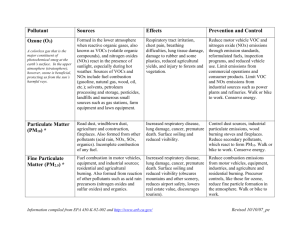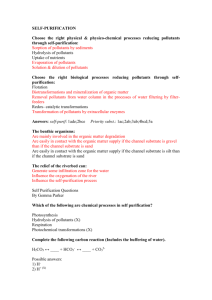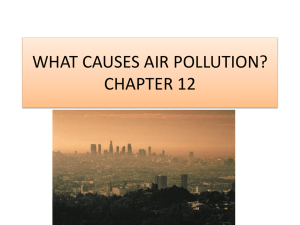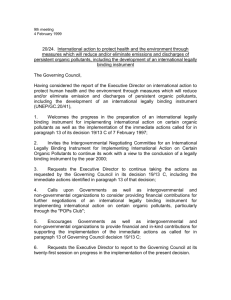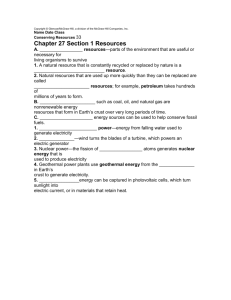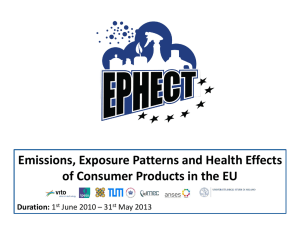Destruction of animal carcasses
advertisement
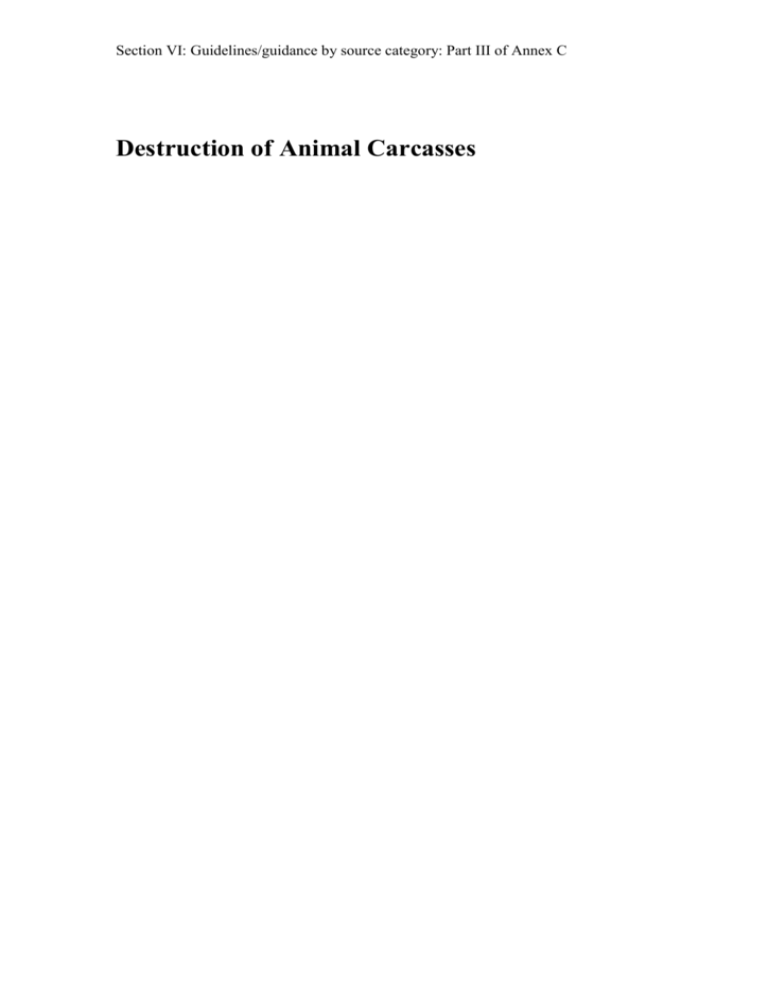
Section VI: Guidelines/guidance by source category: Part III of Annex C Destruction of Animal Carcasses Section VI: Guidelines/guidance by source category: Part III of Annex C Table of Contents Destruction of animal carcasses ..................................................................................... 3 1 Process description............................................................................................. 3 2 Sources of chemicals listed in Annex C of the Stockholm Convention ............ 4 2.1 Emissions of persistent organic pollutants from destruction of animal carcasses ................................................................................................................. 4 2.2 General information on emissions from destruction of carcasses ............. 5 3 Recommended processes ................................................................................... 6 3.1 Overview of disposal options..................................................................... 6 3.2 Best available techniques ........................................................................... 7 3.3 Best environmental practices ..................................................................... 8 4 Primary and secondary measures ....................................................................... 9 4.1 Primary measures ....................................................................................... 9 4.2 Secondary measures ................................................................................. 10 5 Summary of measures ...................................................................................... 11 6 Achievable performance levels ........................................................................ 13 References ............................................................................................................ 13 Section VI: Guidelines/guidance by source category: Part III of Annex C Destruction of animal carcasses Summary The formation and emission of PCDD, PCDF, PCB and HCB from animal carcass incinerators is due to the presence of these chlorinated materials, precursors and chlorine in the carcasses or in some plastics that can be co-incinerated with animal carcasses and by-products. Measures that can be taken to decrease the formation and release of persistent organic pollutants include the avoidance of co-incineration with other wastes, the requirement for a furnace temperature of 850° C, a 2-second residence time for the combustion gases and sufficient excess air to ensure combustion. Larger facilities (> 50 kg/h) should be fitted with air pollution control equipment to minimize emissions of sulphur dioxide, hydrogen chloride, carbon monoxide, volatile organic compounds, particulate matter and persistent organic pollutants. A performance level of < 0.1 ng TEQ/Nm3 can be achieved for PCDD/PCDF. Other methods of disposal, such as burial, landfill or composting, are not considered to contribute significantly to emissions of chemicals listed in Annex C, although environmental, public health, nuisance and animal health issues should be considered. Alkaline hydrolysis or digestion is a further technique for the destruction of animal carcasses. 1 Process description Destruction of animal carcasses is generally achieved by incineration, rendering or a combination of these two activities. Incineration techniques may include pyrolysis, gasification or other forms of heat treatment, and may involve burning of complete carcasses or parts of carcasses. Rendering covers a range of activities for processing of carcasses to recover materials. Recent legislation in Europe (EC Directive 1774/2002/EC on Animal By-products) limits the use of materials derived from rendering as human or animal foodstuffs to address public and animal health concerns. In recent years the production of animal by-products has increased, as the market definition of what is considered to be desirable meat products has altered (that is, the proportion of an animal that is considered to be by-product is increasing). Rendering processes include treatment of hides, skins, feathers, organs, bones, trimmings, fluids and fat. In general the rendering process includes the crushing and grinding of byproducts followed by heat treatment (Figure 1). Such processes include: high-pressure, hightemperature hydrolysis; high-pressure hydrolysis biogas process; and biodiesel production and gasification. Separation of melted fat (tallow) from solid material is achieved by centrifuge or press. The solid fraction is commonly ground to a meat and bone meal. Meat and bone meal has traditionally been used as a feed supplement for animals but has been banned for such use in the European Union (EU), and is now burnt in appropriate waste incineration facilities or buried. One of the current options is the use of meat and bone meal as alternative fuel in cement kilns (see section V.B of the present guidelines). Tallow is used in a wide range of industries (including the food industry), particularly the oleochemical industry, which refines tallow into a wide range of products. In the EU, tallow derived from older animals and other specified risk material is treated separately and is not used for food production but rather is treated as a waste. It can, however, be used as a fuel Section VI: Guidelines/guidance by source category: Part III of Annex C (within the EU combustion is governed by further specific legislation – the Waste Incineration Directive, EC Directive 2000/76/EC). Figure 1. Schematic of traditional continuous rendering process for carcass destruction Source: EPA 1995. Animal carcass incineration is undertaken using a variety of furnace types. Small carcass incinerators may have a simple combustion chamber without any active agitation of the carcass. Larger facilities may employ a rotary kiln to aid agitation and breakdown of the carcass. Similarly, a moving hearth furnace may provide similar agitation. In general, combustion of a complete carcass is difficult. Combustion in furnaces is more controllable if a more even feed process can be employed, such as maceration, grinding or other techniques. 2 Sources of chemicals listed in Annex C of the Stockholm Convention 2.1 Emissions of persistent organic pollutants from destruction of animal carcasses The formation and emission of polychlorinated dibenzo-p-dioxins (PCDD), polychlorinated dibenzofurans (PCDF), polychlorinated biphenyls (PCB) and hexachlorobenzene (HCB) from animal carcass incinerators is due to the presence of these materials, precursors or chlorine in the carcasses or in some plastics which can be co-incinerated with carcass material. However, although measurements of PCDD and PCDF emissions from incineration plant have been undertaken, there are very few data for PCB and HCB emissions. Consequently PCB and HCB emission levels are much more uncertain than those of PCDD and PCDF from such plant. In general, rendering processes are considered to be unlikely sources of persistent organic pollutants. However, there is potential for concentration of material in the carcass residues and release from downstream activities (for example, combustion of material). Section VI: Guidelines/guidance by source category: Part III of Annex C 2.2 General information on emissions from destruction of carcasses 2.2.1 Incineration Airborne emissions consist of nitrogen oxides (NOx), carbon monoxide (CO), sulphur dioxide (SO2), particulate matter, metal compounds, organic compounds and PCDD/PCDF. Larger incineration plant may have sophisticated air pollution control equipment (for example, fabric filtration, lime injection and activated carbon injection). Smaller units include incinerators for slaughterhouse by-products and for veterinary devices, incinerators on farms for disposal of fallen stock and pet crematoria. These can have pollution control measures ranging from minimal (i.e., a combustion chamber and stack) to reasonably sophisticated systems with secondary combustion chambers, afterburners and filtration. Other emission routes include ash and air pollution control residues, primarily to land. Significant releases to water are considered unlikely. 2.2.2 Open burning Uncontrolled or open burning of animal carcasses is not uncommon. However, burning of more than a handful of carcasses at any one time is more uncommon. The government of the United Kingdom employed mass burning in 2001 as part of the measures to control an outbreak of foot-and-mouth disease but is unlikely to consider such measures appropriate in the future (Table 1). Table 1. UK 2001 foot-and-mouth disease outbreak: Carcass disposal Disposal method Burning (on farm) Burial (on farm) Provisional statistics > 950 sites 900 sites Mass burial 61,000 tons at 4 sites Commercial landfill 95,000 tons at 29 sites Rendering 131,000 tons at 7 plant Source: Anderson 2002. The emission to atmosphere of PCDD/PCDF from the foot-and-mouth disposal pyres in 2001 was estimated to be about 0.7 g, compared to a total United Kingdom emission of 314 g (NAEI website). Air curtain incinerators offer a level of sophistication between pyres and incinerators but tend not to be permanent facilities, larger units are essentially engineered pits with the air blower and direction equipment attached alongside. Such units offer improved combustion over open burning and have applications in large scale animal slaughtering for disease control. Ash disposal to land and potential releases to water need to be considered for open or pit burning. 2.2.2 Emissions from rendering Rendering processes include treatment of hides, skins, feathers, organs, bones, trimmings, fluids and fat. Rendering includes the crushing and grinding of by-products followed by heat treatment. Separation of melted fat (tallow) from solid material is achieved by centrifuge and press. The solid fraction is commonly ground to a meat and bone meal. Generally, the emissions that arise from combustion processes associated with rendering (for example, furnaces for generating steam for heat treatment) do not contain persistent organic Section VI: Guidelines/guidance by source category: Part III of Annex C pollutants, but odorous and volatile organic compound emissions can arise from various rendering activities. Meat and bone meal that is burnt can give rise to emissions of persistent organic pollutants. In the EU, meat and bone meal is now burnt in appropriate incineration or co-incineration facilities or buried. 2.2.3 Emissions of persistent organic pollutants to air For general information about PCDD and PCDF formation mechanisms see Section III.C (i). As an example, new animal carcass incinerators in the United Kingdom are generally required to achieve PCDD/PCDF emission concentrations of less than 0.1 ng TEQ/m3 standardized at 11% oxygen, dry and standard pressure and temperature (0° C, 101.3 kPa). 1 New lowcapacity incinerators (average throughput < 50 kg/h) do not have emission limits but are required to operate under a type approval scheme. To achieve type approval the regulatory guidance requires the incinerator manufacturer to show that the machines operate at a temperature in excess of 850º C for a residence time of 2 seconds. It is also noted that the requirements are likely to be met by designs that include a secondary combustion chamber with afterburners. An emissions survey of existing low-capacity incinerators was undertaken for DEFRA (AEA Technology 2002) prior to introduction of the new rules and indicated average PCDD/PCDF concentrations of 0.05–0.40 ng TEQ/m3. It should be noted that low-capacity, on-farm incineration is banned in several countries. 2.2.4 Releases to other media Process, surface and cooling water can be contaminated by body fluids, suspended solids, fats and oils. Carcasses, ash and other by-products are disposed of to land. Waste products disposed of properly to landfill are not anticipated to give rise to large risk of population exposure; the main route for such exposure is considered to be emissions to air. 3 Recommended processes 3.1 Overview of disposal options Some countries have adopted a policy of no burial of animals and by-products. In some countries high-capacity centralized facilities have been adopted for disposal of carcasses; some countries have banned on-farm incineration of animal carcasses. Other countries have a mix of large facilities, small facilities (for example on-farm incinerators) and landfill. Disposal to landfill will not eliminate persistent organic pollutants that may be present within the carcasses but should remove them from potential human exposure. The approach adopted by a country has to reflect the specific nature and circumstances of food production, slaughterhouses and rendering activities in the country (including infrastructure, and cultural constraints and practices). For example, large-scale central incineration facilities require a sophisticated transport infrastructure to minimize risk of infection from moving potentially infected material and a pricing structure capable of supporting the facility. In the destruction of animal carcasses, the main source of emissions of chemicals listed in Annex C is the incineration of animal carcasses and by-products (including by-product arising from rendering processes). Combustion facilities for carcasses and rendering residues should therefore be designed to address the requirement for a furnace temperature of 850º C, a 2second residence time for the combustion gases and sufficient excess air to ensure 1 1 ng (nanogram) = 1 × 10-12 kilogram (1 × 10-9 gram). For information on toxicity measurement see section I.C, paragraph 3 of the present guidelines. Section VI: Guidelines/guidance by source category: Part III of Annex C combustion. Designs that cannot achieve these criteria should not be used unless demonstrated to be capable of operating without significant emission of persistent organic pollutants. Larger facilities, such as may be regulated under the Integrated Pollution Prevention and Control Directive in the EU, or equivalent pollution prevention legislation in other countries, may also have substantial air pollution control requirements to meet emission requirements for other species. These may include (for example) selective non-catalytic reduction for NOx control, lime injection for acid gas control (SO2 and HCl), carbon injection for mercury and PCDD/PCDF control, and fabric filtration for particulate matter control. Smaller incineration units are unlikely to have a significant national or local impact on air quality. In such instances it will be adequate to adopt the furnace temperature and residence time requirements for control of emissions of persistent organic pollutants. 3.2 Best available techniques Best available techniques are considered to include technology, management and operation parameters, and control of emissions of persistent organic pollutants would comprise the following measures: Combustion furnace meeting the minimum temperature, residence time and oxygen requirements and demonstrated to meet those requirements; Suitable air pollution control equipment, including temperature management to control residence time in reformation window, carbon injection and fabric filtration or equivalent; Design of waste feed system to minimize effect of new charges of waste (feed should be macerated and passed to furnace using a sealed system); Combustion chambers and casings should be made as airtight as possible and operate under reduced pressure to minimize release of furnace gases; Gas temperatures should be monitored to allow control systems to maintain minimum temperature criteria (through use of support fuel burners) and provide interlocking to stop feed when temperature falls below minimum; Flue gas oxygen and carbon monoxide levels should be monitored and linked to the control system to ensure adequate control of air supplies and address any combustion problems; Support fuels should not be waste-derived fuels unless demonstrated to emit no more persistent organic pollutants than gas oil or other clean fuel; Designated hard standing areas with appropriate drainage for loading, unloading, container washing to facilitate cleaning and disinfection. Consider need to incinerate wash-down residues for control of pathogens; Mechanized loading and handling of waste materials to minimize exposure to operators; Small incinerator facilities (where operation of these is permitted) should be located on a concrete slab and be located at least 100 metres from any well, spring or surface watercourse. Similarly, such facilities should be located at least 6 metres from any building or potentially flammable structure; Waste storage facilities to be refrigerated, lockable and rodent and bird proof and have odour control; Section VI: Guidelines/guidance by source category: Part III of Annex C Minimize use of plastic bags to contain waste; consider use of skips, which avoid need for contact with animal remains; Ash recovery to be in sealed conveyors, covered skips and sealed containers to avoid fugitive dust releases (particularly of air pollution control residues). Ash to be disposed of to suitable landfill; Management of incoming waste and record keeping; Effective operation control, inspection and preventive maintenance of components whose failure could impact on environment by releasing persistent organic pollutants; Operator competencies to be identified and met by suitable training; Application of emission limit values and monitoring of emissions to demonstrate compliance; Disposal of ash and residues by landfill. Best available techniques for other pollutants have not been considered and it should be recognized that other factors will also impact on the definition of what constitutes best available techniques for a facility (for example water use, energy use considerations). 3.3 Best environmental practices For best environmental practices, countries should in the first instance aim to develop facilities for burning carcasses and animal by-products that can meet the minimum furnace temperature, residence time and oxygen criteria. It should be noted that air pollution control equipment may be needed to meet local emissions and air quality regulations for pollutants other than persistent organic pollutants. Where heat recovery or air pollution control equipment is installed, the design of such equipment must address the risk of de novo PCDD/PCDF formation by minimizing the residence time of material in the reformation temperature window. Emissions from such plant should be demonstrated to be free of persistent organic pollutants by measurement on commissioning. Facilities for co-incineration of waste materials (for example tallow or meat and bone meal in cement kilns) should be assessed to ensure that the minimum furnace temperature, residence time and oxygen criteria can be achieved, and emission monitoring should be used to determine compliance with emission limits. The emissions arising from co-incineration of animal waste should not be more polluting than those arising from operation of the process without waste burning. For very small incineration facilities (< 50 kg/h) emissions of persistent organic pollutants may be controlled by using furnaces demonstrated (perhaps, for example, by a type approval scheme) to be capable of operating according to minimum furnace temperature and residence time criteria. In addition, operation should be smokeless and loading and operation procedures may be interlocked to ensure that material cannot be burnt until the secondary chamber reaches the minimum temperature. In such instances it is unlikely that the expense of emission measurements can be justified. Use of pyres should not be considered part of BEP, if pyres are used then care is needed to avoid fuels such as treated wood or other fuels which may include materials which can lead to release of persistent organic pollutants. Limited measurement data (SKM 2005) indicate that Air curtain incinerators may have similar emissions per carcase as small incinerators but the quantities of fuel and carcases (and hence potential emissions) are far higher than for small carcases. Their use should not be considered part of BEP except perhaps as part of a disease control strategy. Section VI: Guidelines/guidance by source category: Part III of Annex C Use of digestion techniques and appropriately designed and managed landfill is an alternative to incineration. 4 Primary and secondary measures 4.1 Primary measures Primary measures are regarded as pollution prevention techniques that reduce or eliminate the generation and release of persistent organic pollutants. Possible measures include: 4.1.1 Furnace design The furnace should provide conditions whereby a temperature of 850ºC can be maintained throughout loading, burning and discharge of the carcasses with a gas residence time of 2 seconds and sufficient oxygen to ensure destruction of any residual persistent organic pollutants. It is likely that a secondary combustion chamber will be required with afterburners and/or air injection to meet these criteria. Particular care should be taken to ensure adequate sizing of the secondary chamber and the qualifying volume (the volume downstream of the last injection of fuel or combustion air and with a minimum gas temperature of 850º C throughout the volume). Ideally the furnace should be designed to allow continuous operation (that is, with automatic continuous feed to the furnace and automatic ash removal) as this will minimize process upsets, which can give rise to emission of persistent organic pollutants. Continuous operation requires maceration of solid materials to ensure consistent feed. It is recognized that, for smaller units and units handling whole carcasses, continuous operation may not be appropriate. The design of the furnace needs to facilitate good burnout of the material (low carbon in ash content). Where co-incineration is proposed, the same furnace temperature and residence time criteria should be adopted. 4.1.2 Feed material The presence of plastics and other contaminants (particularly chlorine compounds) in the feed material should be avoided to reduce the generation of persistent organic pollutants during incomplete combustion or by de novo synthesis. It is recognized that use of plastic bags and similar material is necessary for operator and animal hygiene. However, their use should be minimized by use of mechanized and automatic feed devices. It should be recognized that carcasses and by-products may need to be classified according to source (for example, specified risk material). Methods to be considered include: Use of mechanized loaders to avoid contact with carcasses; Use of macerating and grinding techniques to allow automatic, continuous loading and operation; Minimizing contamination from packaging, including use of non-halogenated plastics. 4.1.3 Fuels The use of clean fuels is recommended for start-up, support burners and afterburners. Larger facilities should aim for self-sustaining combustion in the furnace to minimize fuel use. Use of waste-derived or other fuels potentially contaminated with persistent organic pollutants should be minimized and must not be used during start-up or process upset when temperatures are below 850º C and unstable conditions may be present. Section VI: Guidelines/guidance by source category: Part III of Annex C 4.1.4 Effective process control Process control systems should be utilized to maintain process stability and operate at parameter levels that will contribute to the minimization of generation of persistent organic pollutants, such as maintaining furnace temperature above 850 °C to destroy such pollutants. Ideally, emissions of persistent organic pollutants should be monitored continuously to ensure reduced releases. Variables such as temperature, residence time, and levels of CO, volatile organic compounds and other gas components should be continuously monitored and maintained to establish optimum operating conditions. 4.1.5 Operator competency The management of the facility is the key to ensuring safe and environmentally benign operation. All personnel operating the facility shall be fully conversant with their duties, in particular with regard to routine operation, maintenance, disease control, process upset conditions and local environmental legislation. The competency of operators shall be addressed by suitable training at an appropriate level for the facility. 4.2 Secondary measures Secondary measures are pollution control techniques. These methods do not eliminate the generation of contaminants, but serve as means to contain and prevent emissions. 4.2.1 Fume and gas collection Air emissions should be controlled at all stages of the process, including material handling, combustion and material transfer points, to control the emission of persistent organic pollutants. Sealed furnaces are essential to contain fugitive emissions while permitting heat recovery and collecting off-gases for abatement or discharge. Proper design of hooding and ductwork is essential to minimize fugitive discharge. Sealed skips or enclosed feed systems may be used and can significantly reduce fugitive emissions to air by containing emissions during charging. 4.2.2 Air pollution control equipment Large facilities should employ a range of air pollution control equipment to provide control for all significant emissions to atmosphere. Care in selection, design and use of air pollution control equipment for other pollutants will also, in general, reduce emissions of persistent organic pollutants. The design has to recognize the potential for de novo formation of selected persistent organic pollutants and minimize the potential for such formation. Particulate matter should be removed to reduce PCDD/PCDF emissions to atmosphere (although they will be discharged to landfill). Fabric filters are an effective technique but are essentially lowtemperature devices (up to 200º C). For small facility processes the use of afterburners is probably sufficient abatement to control emission of persistent organic pollutants, and particulate abatement is considered unnecessary. Air pollution control operations should be constantly monitored by devices to detect failure. Other more recent developments include online cleaning methods and use of catalytic coatings to destroy PCDD/PCDF. Activated carbon treatment should be considered for removal of persistent organic pollutants from off-gases. Activated carbon possesses a large surface area on which PCDD/PCDF can be adsorbed. Off-gases can be treated with activated carbon using fixed or moving bed reactors, or by injection of carbon particulate into the gas stream followed by removal as a filter dust using high-efficiency dust removal systems such as fabric filters. Section VI: Guidelines/guidance by source category: Part III of Annex C 5 Summary of measures Table 2. Measures for recommended processes for new animal carcass incinerators Measure Recommend ed processes Description Considerations Other comments Large (> 50 kg/h) incinerators and coincinerators Minimum 850º C, 2second residence time in qualifying volume with sufficient air to ensure destruction of persistent organic pollutants. Fit with air pollution control equipment to minimize emissions of SO2, HCl, CO, volatile organic compounds, particulate matter and persistent organic pollutants These are considered to be best available techniques. Should also have management systems in place, demonstration that facility meets emission limit values and regular monitoring to ensure compliance Small (< 50 kg/h) incinerators Minimum 850º C, 2second residence time in qualifying volume with sufficient air to ensure destruction of persistent organic pollutants For smaller plant these conditions should be minimum to address issue of persistent organic pollutants. Could be adopted using a type approval mechanism and inspection of management of facility (rather than expensive emission tests) Table 3. Summary of primary and secondary measures for destruction of animal carcasses Description Measure Considerations Other comments Primary measures Furnace design Control of feed material Best place to maximize destruction of persistent organic pollutants and minimize their formation The presence of plastics and chlorine compounds in the feed material should be minimized to a level consistent with good hygiene to reduce the generation of persistent organic pollutants during Elimination of plastic, maximize use of mechanical handling Fairly low-tech Section VI: Guidelines/guidance by source category: Part III of Annex C Description Measure Considerations Other comments incomplete combustion or by de novo synthesis Fuel Clean fuels for support Effective process control Process control systems should be utilized to maintain process stability and operate at parameter levels that will contribute to the minimization of emission of persistent organic pollutants PCDD/PCDF emissions may be minimized by controlling other variables such as temperature, residence time, gaseous components Use of temperature is a fairly basic control parameter. Monitoring of oxygen, CO and volatile organic compounds is more complex but straightforward. However, main issue is maintenance of a control system able to use data in real time to address combustion air supply dampers, support burners and other control features Secondary measures Fume and gas Collection Effective containment of furnace gases in all conditions of the incineration process to avoid fugitive releases Processes to be considered include: sealed furnaces to contain fugitive emissions while permitting heat recovery and collecting off-gases Air pollution control equipment Particulate matter abatement will help reduce potential emission of persistent organic pollutants. Activated carbon treatment should be considered as this material possesses large surface area on which PCDD/PCDF can be adsorbed from off-gases Fabric filtration is the most effective particulate matter abatement and is consistent with use of dry/semi-dry sorbents for acid gas and metals control. However, it will require a temperature reduction. Injection of powdered activated carbon into the gas stream followed by removal Use of air pollution control devices gives rise to additional waste streams and requires consumables. Likely need to reduce flue gas temperature (to avoid use of more exotic filtration media), consequently care needed to minimize residence in reformation window. Better to avoid formation of persistent organic pollutants in the furnace. Section VI: Guidelines/guidance by source category: Part III of Annex C Description Measure Considerations as a filter dust Other comments However, this approach allows some back-up for process upset conditions and is considered a best available technique in Europe for incineration processes. Most air pollution control equipment is expensive to buy and run, and spares are expensive. 6 Achievable performance levels Achievable performance levels for emissions of persistent organic pollutants from destruction of animal carcasses are shown in Table 4. For further information see European Commission 2003. Table 4. Achievable emission levels for animal carcass and by-product incineration Type Suggested timeline Emission levela PCDD/PCDF Emission levela PCB Emission level HCB New Entry into force < 0.1 ng/Nm3 (TEQ) < 0.1 ng/Nm3 (TEQ) ? Existing Within 10 years of entry into force < 0.1 ng/Nm3 (TEQ) < 0.1 ng/Nm3 (TEQ) ? a. For combustion plant these emission limits are expressed as mass concentrations at 11% oxygen, dry and standard temperature and pressure (0º C, 101.3 kPa). References AEA Technology. 2002. Atmospheric Emissions from Small Carcass Incinerators. Report for the Department for Environment, Food and Rural Affairs. Anderson I. 2002. Foot and Mouth Disease 2001: Lessons to be Learnt Inquiry Report. Stationery Office, London. EPA (United States Environmental Protection Agency). 1995. Meat Rendering Plants. Emission Factor Documentation for Background Report AP-42, Section 9.5.3. EPA, Office of Air Quality Planning and Standards, Emission Factor and Inventory Group, Washington, D.C. European Commission. 2003. Reference Document on Best Available Techniques in the Slaughterhouses and Animal By-products Industries. BAT Reference Document (BREF). European IPPC Bureau, Seville, Spain. eippcb.jrc.es. Section VI: Guidelines/guidance by source category: Part III of Annex C NAEI (National Atmospheric Emissions Inventory). Emission Factors Database. DEFRA (Department for Environment, Food and Rural Affairs). www.naei.org.uk/emissions/index.php. Sinclair Knight Merz , 2005 Air Curtain Incinerator Trial Report. Report for New Zealand Ministry of Agriculture and Forestry
